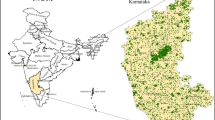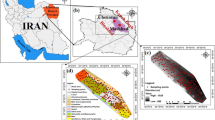Abstract
Spatial information of soil depth in regional and national level is essential for arriving crop suitability decisions. In the present study, high-resolution (250 m) soil depth map of Karnataka is prepared using digital soil mapping approach. A total of 5174 Soil legacy datasets studied by NBSS&LUP over a period of 30 years is collected and organized for mapping. Quantile regression forest (QRF) and regression kriging (RK) algorithm is tested to predict the soil depth in Karnataka. Topographic attributes derived from digital elevation model, normalized difference vegetation index, landsat-8 data and climatic variables are used as covariates. For model calibration, 80% of soil depth data is used and 20% of data is used for validation. The classical uncertainty estimates such as coefficient of determination (R2) and root mean square error (RMSE) and bias were calculated for the validation datasets in order to assess the model performance. RK model explained maximum variability for prediction of soil depth (R2 = 30%, RMSE = 34 cm) compared to QRF (R2 = 17%, RMSE = 37 cm). Lithology and elevation are found to be most important variables for prediction of soil depth in Karnataka. The predicted soil depth in Karnataka is ranged from 22 to 173 cm, and the present high-resolution (250 m) soil depth maps are useful in different hydrological, crop modelling and climate change studies.





Similar content being viewed by others
References
Arrouays, D., Grundy, M. G., Hartemink, A. E., Hempel, J. W., Heuvelink, G. B., Hong, S. Y., Lagacherie, P., Lelyk, G., McBratney, A. B., McKenzie, N. J., dL Mendonca-Santos, M., Minasny, B., Montanarella, L., Odeh, I. O., Sanchez, P. A., Thompson, J. A., Zhang, G. –L. (2014). Chapter THREE—GlobalSoilMap: Toward a fine-resolution global grid of soil properties. In Advances in agronomy (pp. 93–1340.
Breiman, L. (2001). Random forests. Machine Learn. https://doi.org/10.1023/A:1010933404324.
Catani, F., Segoni, S., & Falorni, G. (2010). An empirical geomorphology-based approach to the spatial prediction of soil thickness at catchment scale. Water Resources Research, 46(5), W05508.
D’Odorico, P. (2000). A possible bistable evolution of soil thickness. Journal of Geophysical Research, 105(B11), 25927–25935.
Dharumarajan, S., Hegde, R., Janani, N., & Singh, S. K. (2019). The need for digital soil mapping in India. Geoderma Regional. https://doi.org/10.1016/j.geodrs.2019.e00204.
Dharumarajan, S., Hegde, R., & Singh, S. K. (2017). Spatial prediction of major soil properties using random forest techniques—A case study in semi-arid tropics of South India. Geoderma Regional, 10C, 154–162. https://doi.org/10.1016/j.geodrs.2017.07.005.
Dharumarajan, S., Kalaiselvi, B., Suputhra, A., Lalitha, M., Hegde, R., Singh, S. K., et al. (2020). Digital soil mapping of key GlobalSoilMap properties in northern Karnataka plateau. Geoderma Regional. https://doi.org/10.1016/j.geodrs.2019.e00250.
Han, X., Liu, J., Mitra, S., Li, X., Srivastava, P., Guzman, S. M., et al. (2018). Selection of optimal scales for soil depth prediction on headwater hillslopes: A modeling approach. CATENA, 163, 257–275. https://doi.org/10.1016/j.catena.2017.12.026.
Hinge, G., Surampalli, R. Y., & Goyal, M. K. (2018). Prediction of soil organic carbon stock using digital mapping approach in humid India. Environmental Earth Sciences, 77, 172.
Kuriakose, S. L., Devkota, S., Rossiter, D. G., & Jetten, V. G. (2009). Prediction of soil depth using environmental variables in an anthropogenic landscape, a case study in the Western Ghats of Kerala, India. CATENA, 79, 27–38.
Lacoste, M., Minasny, B., McBratney, A. B., Michot, D., Viaud, V., et al. (2014). High resolution 3D mapping of soil organic carbon in a heterogeneous agricultural landscape. Geoderma, 213, 296–311.
Lagacherie, P. (2008). Digital soil mapping: A state of the art. In A. E. Hartemink, A. McBratney, & M. Mendonça-Santos (Eds.), Digital soil mapping with limited data. Dordrecht: Springer. https://doi.org/10.1007/978-1-4020-8592-5_1.
Li, A. D., Tan, X., Wu, W., Liu, H. B., & Zhu, J. (2017). Predicting active layer soil thickness using topographic variables at a small watershed scale. PLoS ONE, 12, e0183742.
Liaw, A., & Wiener, M. (2002). Classification and regression by random forest. R News, 2, 18–21.
Lu, Y.-y., Liu, F., Zhao, Y.-g., Song, X.-d., & Zhang, G.-l. (2019). An integrated method of selecting environmental covariates for predictive soil depth mapping. Journal of Integrative Agriculture, 18, 301–315. https://doi.org/10.1016/S2095-3119(18)61936-7.
McBratney, A. B., Mendonça-Santos, M. L., & Minasny, B. (2003). On digital soil mapping. Geoderma, 117, 3–52. https://doi.org/10.1016/S0016-7061(03)00223-4.
Meinshausen, N. (2006). Quantile regression forests. Journal of Machine Learning Research, 7, 983–999.
Minasny, B., & McBratney, A. B. (1999). A rudimentary mechanistic model for soil production and landscape development. Geoderma, 90, 3–21.
Odeh, I. O. A., McBratney, A. B., & Chittleborough, D. J. (1995). Further results on prediction of soil properties from terrain attributes: Heterotopic cokriging and regression kriging. Geoderma, 67(3–4), 215–226.
Penížek, V., & Borůvka, L. (2006). Soil depth prediction supported by primary terrain attributes: A comparison of methods. Plant, Soil and Environment, 52(9), 424–430.
Reddy, N. N., Chakraborty, P., Roy, S., Singh, K., Minasny, B., McBratney, A. B., et al. (2021). Legacy data-based national-scale digital mapping of key soil properties in India. Geoderma. https://doi.org/10.1016/j.geoderma.2020.114684.
Saulnier, G.-M., Beven, K., & Obled, C. (1997). Including spatially variable effective soil depths in TOPMODEL. Journal of Hydrology, 202(1–4), 158–172.
Shivaprasad, C. R., Reddy, R. S., Sehgal, J., Velayutham. M. (1998). Soils of Karnataka for optimizing land use. NBSS&LUP publication No.47b, Nagpur.
Sreenivas, K., Dadhwal, V. K., Kumar, S., Harsha, G. S., Mitran, T., Sujatha, G., et al. (2016). Digital mapping of soil organic and inorganic carbon status in India. Geoderma, 269, 160–173. https://doi.org/10.1016/j.geoderma.2016.02.002.
Tesfa, T. K., Tarboton, D. G., Chandler, D. G., & McNamara, J. P. (2009). Modeling soil depth from topographic and land cover attributes. Water Resources Research, 45, W10438. https://doi.org/10.1029/2008WR007474.
Tsai, C. C., Chen, Z. S., Duh, C. T., & Horng, F. W. (2001). Prediction of soil depth using a soillandscape regression model: a case study on forest soils in southern Taiwan. National Science Council of the Republic of China, Part B: Life Sciences, 25(1), 34–39.
Vaysse, K., & Lagacherie, P. (2017). Using quantile regression forest to estimate uncertainty of digital soil mapping products. Geoderma, 291, 55–64. https://doi.org/10.1016/j.geoderma.2016.12.017.
Zahedi, S., Shahedi, K., Rawshan, M. H., Solimani, K., & Dadkhah, K. (2017). Soil depth modelling using terrain analysis and satellite imagery: the case study of Qeshlaq mountainous watershed (Kurdistan, Iran). Journal of Agricultural Engineering, 48, 167–174.
Acknowledgements
This work is part of IndianSoilGrid project supported by ICAR-National Bureau of Soil Survey and Land Use Planning. The authors thanks scientists and technical officers of ICAR-NBSS& LUP who have worked in SRM project of Karnataka, Sujala III project and institute projects. The authors also thanks Mrs. Sujatha, Technical officer for her help in developing database.
Author information
Authors and Affiliations
Corresponding author
Additional information
Publisher's Note
Springer Nature remains neutral with regard to jurisdictional claims in published maps and institutional affiliations.
About this article
Cite this article
Dharumarajan, S., Vasundhara, R., Suputhra, A. et al. Prediction of Soil Depth in Karnataka Using Digital Soil Mapping Approach. J Indian Soc Remote Sens 48, 1593–1600 (2020). https://doi.org/10.1007/s12524-020-01184-7
Received:
Accepted:
Published:
Issue Date:
DOI: https://doi.org/10.1007/s12524-020-01184-7




